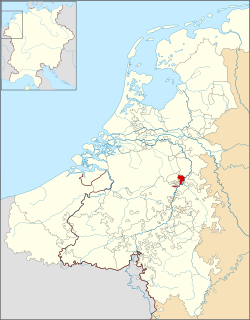

County of Horne
| |||||||||||
|---|---|---|---|---|---|---|---|---|---|---|---|
| 920–1795 | |||||||||||
|
Coat of arms | |||||||||||

Lordship of Horne (1350)
| |||||||||||
| Status | County | ||||||||||
| Capital | Horn | ||||||||||
| Common languages | Limburgish, Dutch | ||||||||||
| Religion | Roman Catholicism | ||||||||||
| Historical era | Middle Ages | ||||||||||
• Established | 920 | ||||||||||
| 1568 | |||||||||||
| 1795 | |||||||||||
| 10 September 1801 | |||||||||||
| |||||||||||



Horne (also Horn, HoornorHoorne) is a small historic county of the Holy Roman Empire in the present day Netherlands and Belgium. It takes its name from the village Horn, west of Roermond. The residence of the counts of Horne was moved from Horn to Weert in the 15th century.
After the execution in 1568 of Philip de Montmorency who died without male heirs, the Prince-Bishop of Liège, as suzerain of Horne, was declared the direct lord and new count. The bishops ruled the county in personal union. Horne maintained its own laws and customs as well as its financial autonomy. The county included the communes of Neer, Nunhem, Haelen, Buggenum, Roggel, Heythuysen, Horne, Beegden, Geystingen and Ophoven.[1]
It was suppressed in 1795, when it was occupied by the French, and it became part of the French département Meuse-Inférieure.
|
| |||||||
|---|---|---|---|---|---|---|---|
| Prince-bishops |
|
| |||||
| Prince-abbots |
| ||||||
| Secular |
| ||||||
| Counts / Lords |
| ||||||
| Cities |
| ||||||
1 from 1648 2 until 1648 3 without seat in Imperial Diet ? status uncertain
Circles est. 1500: Bavarian, Swabian, Upper Rhenish, Lower Rhenish–Westphalian, Franconian, (Lower) Saxon
| |||||||
This Dutch-history-related article is a stub. You can help Wikipedia by expanding it. |
This Belgian history-related article is a stub. You can help Wikipedia by expanding it. |